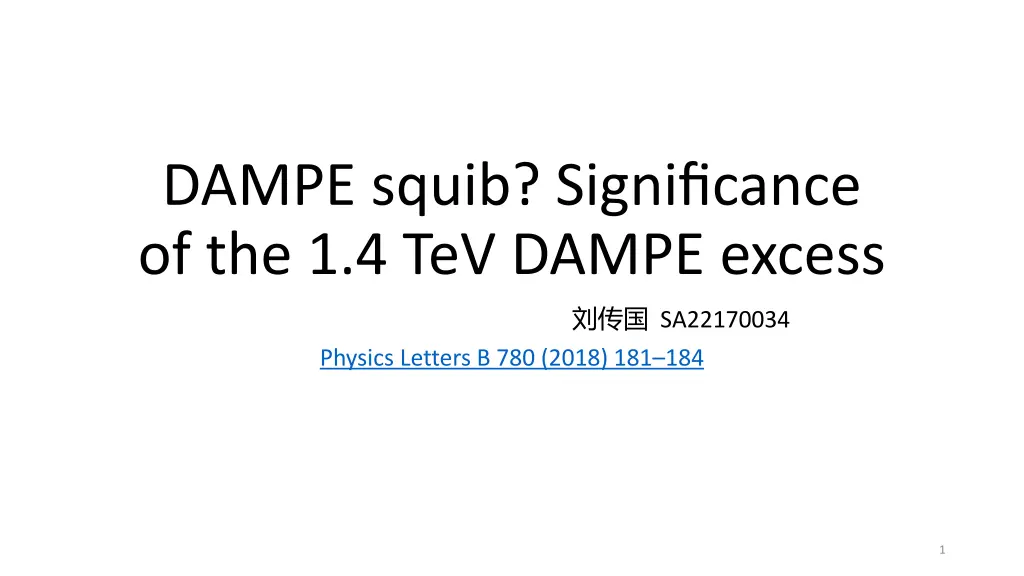
Significance of the 1.4 TeV DAMPE Excess in Physics Letters B 780
Explore the significance of the 1.4 TeV DAMPE excess in Physics Letters B 780, where the Dark Matter Particle Explorer (DAMPE) experiment reveals intriguing features in the electron and positron energy spectrum, potentially hinting at dark matter annihilation. Learn about fitting the spectrum with toy models, analyzing flux measurements, and conducting hypothesis tests with chi-squared statistics. Dive into the world of high-energy physics and dark matter exploration.
Download Presentation

Please find below an Image/Link to download the presentation.
The content on the website is provided AS IS for your information and personal use only. It may not be sold, licensed, or shared on other websites without obtaining consent from the author. If you encounter any issues during the download, it is possible that the publisher has removed the file from their server.
You are allowed to download the files provided on this website for personal or commercial use, subject to the condition that they are used lawfully. All files are the property of their respective owners.
The content on the website is provided AS IS for your information and personal use only. It may not be sold, licensed, or shared on other websites without obtaining consent from the author.
E N D
Presentation Transcript
DAMPE squib? Significance of the 1.4 TeV DAMPE excess SA22170034 Physics Letters B 780 (2018) 181 184 1
The Dark Matter Particle Explorer (DAMPE) experiment recently published the energy spectrum of electrons and positions from about 10 GeV to about 4 TeV . The spectrum, by eye, contained two interesting features: a break at about 1 TeV and a monochromatic excess at about 1.4 TeV. dark matter (DM) was invoked to explain the excess. DM with a mass of about 1.4 TeV could annihilate into electrons in a subhalo within about a kpc resulting in a narrow spike in the spectrum. 2
we fit the spectrum by three toy models A single power-law (PL) A smoothly-broken power-law (SBPL) A half-normal distribution upon a smoothly-broken power-law (signal) 3
DAMPE measured the average flux in 38 energy bins. We may predict the average flux in the i-th bin by where the bin spans energies ai to bi .<Ei> is defined by The SBPL and PL fluxes are, however, approximately linear on scales similar to the bin width such that it approximately holds, 4
The signal model contains a peak that may be narrower than the bin width and we must explicitly calculate it,i.e., This subtlety means that previous calculations of the required amplitude of a DM signal are underestimates by a factor of approximately the bin width divided by the signal width, E/ 5 20 5
We performed two hypothesis tests: an SBPL versus a single PL under the hypothesis of a single PL, and an SBPL versus a signal under the hypothesis of an SBPL. We performed the former to validate our methodology against a result published by DAMPE. We used chi-squared test-statistics The chi-squared itself was We minimised the chi-squared with a CMA-ES evolutionary algorithm implemented in stochopy. 6
we generated 1000 pseudo-datasets from the best-fit single PL and best-fit SBPL models and reminimised the test-statistic for each dataset and model.we estimated the p-value by the fraction of pseudo-experiments in which the test-statistic exceeded that observed. 7
For the hypothesis test of the PL versus SBPL, we found no differences in chi-squared between the PL and SBPL models . This resulted in a p-value associated with the PL model of at most 0.002, which is equivalent to at least 2.9 . DAMPE applied Wilks theorem to estimate the significance, finding 6.6 . We found about 7 with a similar procedure. 8
For the hypothesis test of the SBPL versus signal model, only 11 of our 1000 pseudo-experiments under the SBPL hypothesis had differences in chi-squared.resulting in a global significance of about 2.2 2.4 . This includes a two-dimensional look-elsewhere effect in the mass and width of the excess and corresponds to a p-value of about 1%. The local significance was about 3.6 , assuming a 1/2 2distribution for the test- statistic. To validate our methodology, we checked that our Monte Carlo reproduced a 1/2 2distribution from a model with a fixed mass and width 9
The DM signal must have a mass of about 1300 GeV to 1500 GeV, a width of less than about 100 GeV, and an amplitude of about 10 5/s/sr/m2. This amplitude corresponds to a peak flux of about 10 7/GeV/s/sr/m2 for a signal width of = 10 GeV 10
We considered Bayes factors between the three competing models of the spectrum. The Bayes factor where x represents a model s parameters, p(D | M, x) =1/2 2is our likelihood function and p(x | M) are our priors for the model s parameters. 11
the SBPL model was favoured against the single PL model by about 1010 the signal model was favoured versus an SBPL by a Bayes factor of about 2. We anticipate that changes in priors for could not substantially modify the Bayes factor. the Bayes factor increased to 4 with linear rather than logarithmic priors for the mass, amplitude and width of the DM signal. The maximum Bayes factor achievable with any priors is about 500. 12
For the SBPL versus the PL, we found a Bayes factor of about 1010and a p-value of about 10 12. For the signal versus the SBPL, we found a Bayes factor of about 2 and a global p-value of about 1%. 13
